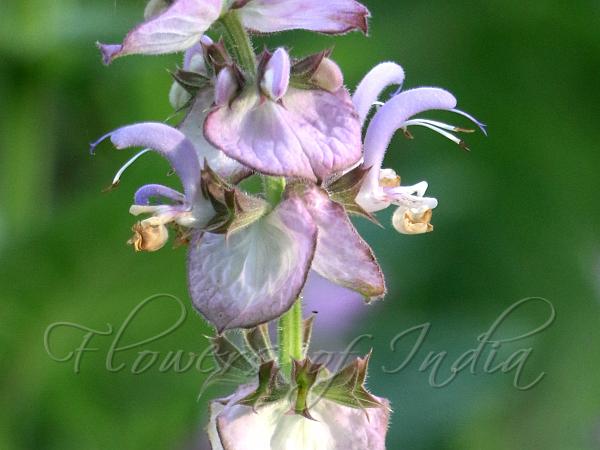|
| Clary Sage |
|

|

| File size | 522146 |
| Original date | 6/29/19 6:16 PM |
| Resolution | 5472 x 3648 |
| Flash | Flash did not fire |
| Focal length | 135.0mm |
| Exposure time | 1/200s |
| Aperture | 6.3 |
| Focus Distance | |
| Metering Mode | Multi-segment |
| Camera make | Canon |
| Camera model | Canon EOS 7D Mark II |
| Sensor type |
|
|
|
|
Photo: |
Botanical name: Salvia sclarea Family: Lamiaceae (Mint family)
Synonyms: Salvia asperata, Salvia pamirica, Salvia haematodes (illeg.)
Synonyms: Salvia asperata, Salvia pamirica, Salvia haematodes (illeg.)
Clary Sage is a biennial or short-lived perennial herb, reaching 1-1.3 ft
in height, with square stems that are covered with hairs. Leaves are ovate
to ovate-oblong, approximately 1 ft long at the base, 0.5 ft long higher
on the plant. The
upper leaf surface is rugose, and covered with glandular hairs. Flowers
are arranged in showy spikes of numerous 6-10-flowered distant
verticillasters. Bracts or floral leaves are large, green, white or pink,
membranous, cuspidate, as long as or longer than flowers. Flower-stalks
are 2-3 mm, spreading-erect. Sepal cup is ovate-bell-shaped, about 1 cm in
flower lengthening to about 1.3 cm in fruit, with glandular and eglandular
hairs and stalkless glands. Upper lip with 3 spinulose teeth; lower lip
with 2 narrow ovate spinulose teeth. Flowers are white, lilac or cream,
2-3 cm; upper lip sickle-shaped, tube about 1 cm long. Stamens have an
elongated connective and a sterile dolabriform lower theca. Nutlets are 4,
about 3 x 2 mm, round, scarcely trigonous, rounded, pale brown with darker
veins. Clary Sage is found in W. Asia, parts of the Himalayas and S. Europe.
Medicinal uses: The distilled essential oil is used widely in
perfumes and as a muscatel flavoring for vermouths, wines, and liquors.
Clary seeds have a
mucilaginous coat, which is why some old herbals recommended placing a
seed into the eye of someone with a foreign object in it so that it
could adhere to the object and make it easy to remove. This practice is
noted by Nicholas Culpeper in his Complete Herbal (1653), who referred
to the plant as "clear-eye".
The distilled essential oil is used widely in
perfumes and as a muscatel flavoring for vermouths, wines, and liquors.
Clary seeds have a
mucilaginous coat, which is why some old herbals recommended placing a
seed into the eye of someone with a foreign object in it so that it
could adhere to the object and make it easy to remove. This practice is
noted by Nicholas Culpeper in his Complete Herbal (1653), who referred
to the plant as "clear-eye".
Medicinal uses:
 The distilled essential oil is used widely in
perfumes and as a muscatel flavoring for vermouths, wines, and liquors.
Clary seeds have a
mucilaginous coat, which is why some old herbals recommended placing a
seed into the eye of someone with a foreign object in it so that it
could adhere to the object and make it easy to remove. This practice is
noted by Nicholas Culpeper in his Complete Herbal (1653), who referred
to the plant as "clear-eye".
The distilled essential oil is used widely in
perfumes and as a muscatel flavoring for vermouths, wines, and liquors.
Clary seeds have a
mucilaginous coat, which is why some old herbals recommended placing a
seed into the eye of someone with a foreign object in it so that it
could adhere to the object and make it easy to remove. This practice is
noted by Nicholas Culpeper in his Complete Herbal (1653), who referred
to the plant as "clear-eye". | Identification credit: Gurcharan Singh | Photographed in Kashmir. |
• Is this flower misidentified? If yes,